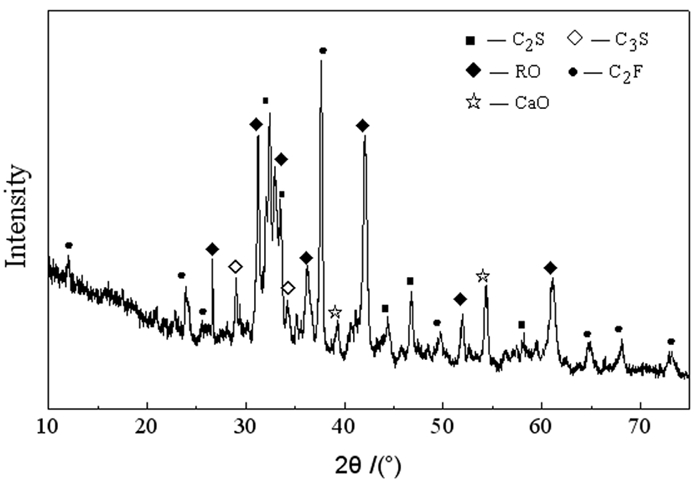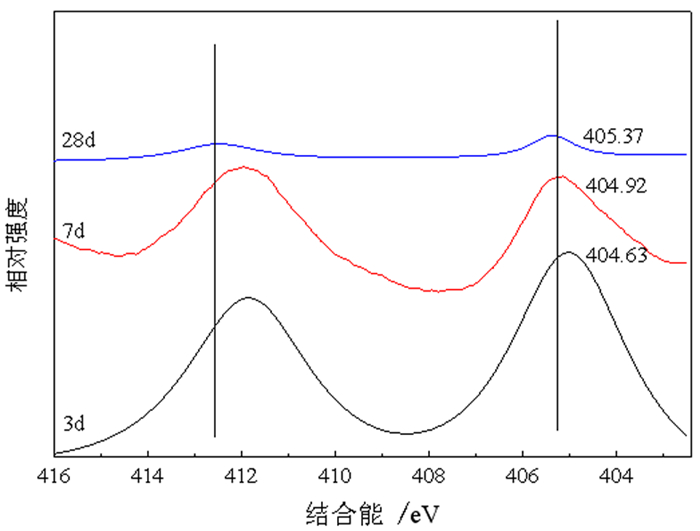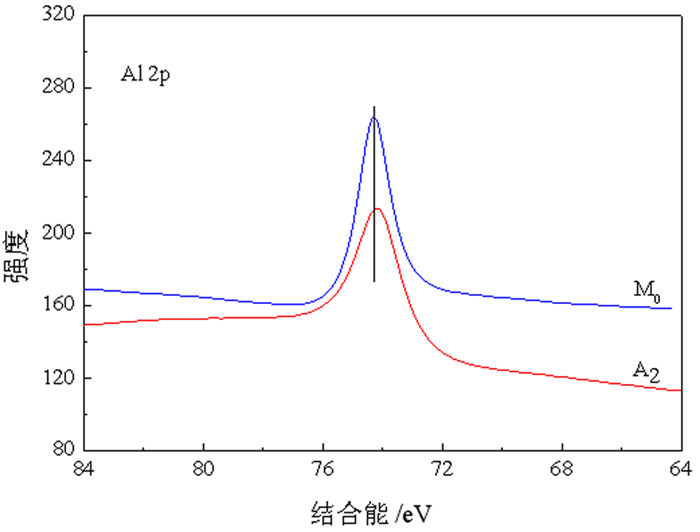Study on the Stabilization of Cd2+ by Cementitious Materials Prepared with Metallurgical Slag
-
摘要:
以钢渣、矿渣和脱硫石膏为原料制备胶凝材料,研究了其对镉离子的固化效果。研究结果表明:在Cd2+浓度不高于30 mg/kg时,胶凝材料对镉离子吸附效果较好,主要是因为镉离子能够以"类质同象"的方式替代Ca2+进入钙矾石(AFt)的晶格和Friedel盐,形成含镉复盐而被固化,再加上C-S-H对镉的吸附作用,共同促使Cd2+被高效固化。研究结果对于含镉废水的治理具有重要意义。
Abstract:The cementitious materials were prepared with steel slag, blast furnace slag and desulfurization gypsum and its stabilization effect on Cd2+ was studied. The results showed that the cementitious materials had a better adsorption effect on Cd2+ when the concentration of Cd2+ was not higher than 30 mg/kg. The reasons were as follows. Cadmium ions could replace Ca2+ into the lattice of ettringite (AFt) and Friedel salt by a "quasi-homogeneous" manner. Then it formed a cadmium-containing double salt and was solidified. Coupled with the adsorption of C-S-H on cadmium, Cd2+ was finally cured efficiently. The research results have great significance for the treatment of wastewater containing cadmium.
-
Key words:
- cementitious material /
- cadmium ions /
- adsorption /
- synergistic effect
-

-
表 1 原料的主要化学成分
Table 1. Chemical composition of materials
/% 原料 SiO2 Al2O3 Fe2O3 CaO MgO SO3 Na2O K2O TiO2 烧失量 钢渣 19.16 7.39 18.66 43.58 7.56 0.26 0.10 0.12 1.65 1.52 矿渣 29.15 11.37 2.66 41.23 10.67 1.11 0.27 0.32 1.45 1.77 脱硫石膏 3.28 1.44 0.76 44.29 0.60 46.06 0.11 0.29 0.08 3.09 表 2 Cd2+浓度对固镉试样力学性能的影响
Table 2. Effect of Cd2+ concentration on mechanical properties of solid cadmium samples
编号 龄期 3 d 7 d 28 d M0 6.7 13.2 18.6 M1 10.3 15.7 20.7 M2 12.7 16.2 21.6 M3 11.0 17.7 22.9 表 3 不同养护龄期固镉试样的Cd2+浸出浓度
Table 3. Cd2+ leaching concentration of Cd solid samples at different curing ages
编号 Cd2+浸出浓度/ (mg·L-1) 3 d 7 d 28 d M0 ND ND ND M1 0.001 ND ND M2 0.003 0.001 ND M3 0.004 0.002 ND 注: ND代表低于检出限0.005 mg·L-1。 -
[1] LIN WANG, XIANGFEN CUI, HONGGUANG CHENG, et al. A review of soil cadmium contamination in China including a health risk assessment[J]. Environmental science and pollution research international, 2015, 22(21): 16441-16452. doi: 10.1007/s11356-015-5273-1
[2] XIAOJUAN LIU, GUANGJIN TIAN, DONG JIANG, et al. Cadmium (Cd) distribution and contamination in Chinese paddy soils on national scale[J]. Environmental science and pollution research, 2016(23): 17941-17952. http://link.springer.com/10.1007/s11356-016-6968-7
[3] HU YUANAN, CHENG HEFA, TAO SHU. The challenges and solutions for cadmium-contaminated rice in china: a critical review[J] Environment International, 2016(92-93): 515-532. http://www.sciencedirect.com/science/article/pii/s0160412016301714
[4] 环境保护部, 国土资源部. 全国土壤污染状况调查公报[R]. 2014.
[5] 余德彪, 王建平, 徐乐, 等. 中国镉资源现状分析及可持续发展建议[J]. 中国矿业, 2015, 24(4): 5-8. doi: 10.3969/j.issn.1004-4051.2015.04.002
[6] 周聪. 镉污染土壤原位修复技术的研究进展[J]. 有色冶金设计与研究, 2018, 39(5): 20-24+28. doi: 10.3969/j.issn.1004-4345.2018.05.006
[7] 刘群芳. 从镉污染分析环境安全保护管理策略[J]. 华南大学学报: 社会科学版, 2013, 14(3): 65-67. https://www.cnki.com.cn/Article/CJFDTOTAL-NHDS201303018.htm
[8] JINGJING LIU, FUSHENG ZHA, XU LONG, et al. Effect of chloride attack on strength and leaching properties of solidified/stabilized heavy metal contaminated soils[J]. Engineering geology, 2018(246): 28-35. http://www.sciencedirect.com/science/article/pii/S0013795218305477
[9] HAO LIANG WU, FEI JIN, YU LIN BO, et al. Leaching and microstructural properties of lead contaminated kaolin stabilized by GGBS-MgO in semi-dynamic leaching tests[J]. Construction and building materials, 2018(172): 626-634. http://www.sciencedirect.com/science/article/pii/S0950061818306639
[10] 赵述华, 陈志良, 张太平, 等. 重金属污染土的固化/稳定化处理技术研究进展[J]. 土壤通报, 2013, 44(6): 1531-1536. https://www.cnki.com.cn/Article/CJFDTOTAL-TRTB201306044.htm
[11] HANGHANG ZHAO, XUNRONG HUANG, GUIBIN ZHANG, et al. Possibility of removing cadmium pollution from the environment using a newly synthesized material coal fly ash[J]. Environmental science and pollution research international, 2020(27): 4997-5008. doi: 10.1007/s11356-019-07163-x
[12] LI JIANGSHAN, XUE QIANG, WANG PING, et al. Effect of drying-wetting cycles on leaching behavior of cement solidified lead-contaminated soil[J]. Chemosphere, 2014(117): 10-13. http://www.sciencedirect.com/science/article/pii/S0045653514006870
[13] Wang F., Shen Z. T., Abir A. T. An evaluation of stabilised/solidified contaminated model soil using PC-based and Mg O-based binders under semi-dynamic leaching conditions[J]. Environmental science and pollution research, 2018, 25(16): 16050-16060. doi: 10.1007/s11356-018-1591-4
[14] PAN YIZE, ROSSABI JOSEPH, PAN CHONGGEN, et al. Stabilization/solidification characteristics of organic clay contaminated by lead when using cement[J]. Journal of hazardous materials, 2019, (362): 132-139.
[15] YASONG FENG, YANJUN DU, WEIYI XIA., et al. Diffusion characteristics of Lead, Zinc, Cadmium in a novel phosphate-based binder stabilized soil[C]. The international congress on environmental geotechnics, Springer, Singapore, 2018: 669-675.
[16] 洪正义, 孙树林. 钢渣-水泥固化Cd污染土的强度特性研究[J]. 科学技术与工程, 2016, 16(8): 248-253. doi: 10.3969/j.issn.1671-1815.2016.08.042
[17] 崔孝炜, 倪文, 任超. 钢渣矿渣基全固废胶凝材料的水化反应机理[J]. 材料研究学报, 2017, 31(9): 687-694. https://www.cnki.com.cn/Article/CJFDTOTAL-CYJB201709007.htm
[18] 蓝俊康, 丁凯, 王焰新. 钙矾石对Pb, Zn, Cd的化学俘获[J]. 桂林工学院学报, 2005, 25(3): 330-334. doi: 10.3969/j.issn.1674-9057.2005.03.015
[19] POMIES M P, LEQUEUS N, BOCH P. Speciation of cadimium in cement made from raw mixcontaining transition osides[J]. Cement & Concrete Research, 1988(28): 335-340.
[20] 姚燕, 王昕, 颜碧兰, 等. 水泥水化产物结构及其对重金属离子固化研究进展[J]. 硅酸盐通报, 2012, 31(5): 1138-1144. https://www.cnki.com.cn/Article/CJFDTOTAL-GSYT201205021.htm
[21] 田犀卓, 金兰淑, 应博, 等. 钢渣-蒙脱石复合吸附剂对水中Cd2+的吸附去除[J]. 环境科学学报, 2015, 35(1): 207-214. https://www.cnki.com.cn/Article/CJFDTOTAL-HJXX201501025.htm
[22] 杨恒, 倪文, 张思奇, 等. 胶结充填用冶金渣协同垃圾焚烧飞灰固镉机理[J]. 工程科学学报, 2018, 40(9): 1027-1035. https://www.cnki.com.cn/Article/CJFDTOTAL-BJKD201809002.htm
[23] JUANJUAN ZHANG, HE ZHAO, HONGBIN CAO, et al. Removal of Cd~(2+) from water by Friedel's salt (FS: 3CaO·AL2O3·CaCl2·10H2O): Sorption characteristics and mechanisms[J]. Journal of environmental sciences, 2013, 25(9): 1719-1725. doi: 10.1016/S1001-0742(12)60287-3
[24] V. ALBINO, R. CIOFFI, M. MARROCCOLI, et al. Potential application of ettringite generating systems for hazardous waste stabilization[J]. Hazardous materials, 1996, 51(1-3): 241-252. doi: 10.1016/S0304-3894(96)01828-6
[25] 张娟娟, 赵赫, 曹宏斌, 等. Friedel盐对废水中低浓度Cd2+的吸附动力学. 过程工程学报, 2012, 12(4): 590-595. https://www.cnki.com.cn/Article/CJFDTOTAL-HGYJ201204012.htm
[26] A.M. CODY, H. LEE, R. D. CODY, et al. The effect of environment on the nucleation, growth, and stability of ettringite[Ca2Al(OH)6]2·(SO4)3·26H2O[J]. Cement and Concrete Research, 2004(34): 869-881. http://www.sciencedirect.com/science/article/pii/S000888460300382X
-




 下载:
下载:



